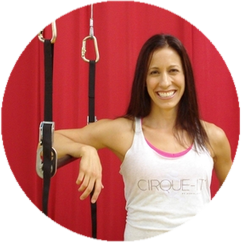 By Elizabeth Skwiot, Special AFS Contributor
By Elizabeth Skwiot, Special AFS Contributor
When I first stepped off a flying trapeze platform at San Francisco’s Circus Center in 2001, I had no idea where that leap of faith would take me. I’ve now created a hybrid circus-inspired fitness concept (Cirque-It Fitness), co-invented and patented a trapeze bar, and educated dozens of fitness professionals across the country. Looking back, I see the flying trapeze taught me lessons that have helped to propel me forward.
Here’s part 1 of “8 lessons the flying trapeze teaches entrepreneurs.”
Choose to be in charge
At 5 foot 3 inches, I’m a bit on the petite size for the flying trapeze. You might think this to be an advantage, but it comes with its challenges.
Many don’t know this, but the trapeze bar itself is rather heavy. It also wants to go. While you’re standing on the platform, you’re holding an upright bar with one hand while the other holds a trapeze bar ready to take you flying. When you first start, a helper on the platform will hold your safety belt so you don’t fly off the platform before you’re ready. As you develop experience, you’ll wean off the helper.
Even without a helper, I always felt at the whim of the bar; it seemed I always took off just before the bar had its way with me. One day, my coach saw my struggle on the platform. From the floor of the gym, he yelled, “Elizabeth, stand tall and pull that shoulder back. Don’t let that bar boss you around.” It was the verbal smack upside the head I needed. I stood tall, puffed out my chest, pulled my shoulder back, and completed my take-off when I was darn well ready.
I continue to remember these words whenever I’m approached by a situation that seems like it’s getting the better of me, and then I remember I’m the one in charge. No situation can pull me in its direction unless I let it. As a business owner, you might feel as if there are a dozen trapeze bars, all demanding your time and attention. Stand tall, pull those shoulders back, and decide what direction you’ll go in and when. You’re in charge of your flight pattern.
You’re never completely in charge
Confidence must certainly be tempered with humility. In the circus, the same rules of physics and safety apply to everyone equally.
The flying trapeze classes I attended attracted a diverse crowd – there were young people just out of high school, corporate cave dwellers, doctors, writers, dot-com millionaires, you name it. Each class seemed to run the spectrum of socioeconomic classes, not to mention attract diverse ethnicities, nationalities, genders, and sexualities.
Yet in class, no one cared how much money anyone had, or that one was a doctor who may have saved a life that day, while another was a young adult floating around living on friends’ couches to have money for the trapeze. Everyone needed to abide by the rules of the gym and help one another. No one was exempt, and no one got special treatment. The trapeze was the Great Equalizer.
As an entrepreneur, I need to remember that I’m not entitled to anything. I need to learn the rules of business and finance. I should respect everyone’s time and be mindful of how I communicate with others. I need to progress at a pace that’s safe and smart for me and my business--to learn a knee hang and a split before a double-twisting layout. Doing too much too soon, acting like the world owes me something, and pretending like the rules apply to everyone but me is sure to be catastrophic—perhaps fatal.
Be in a group that’s better than you
Waiting on the gym floor in between my turns, I once overheard a coach offering some suggestions to another flyer. The coach suggested that the flyer try an additional weekly class and proposed a class time that generally attracted some of the best flyers at the Center.
The flyer conveyed her apprehension at joining a group that threw layouts and somersaults out of lines as a warm-up. The coach’s reply: “If you want to get better, you need to be with people better than you.”
It does me no help as an entrepreneur to spend time with—or worse, take advice from—people who do not push or inspire me to be better. As much as possible, I want to be around high achievers, whether it’s in fitness, business, athletics, or another field. If I want to be a successful entrepreneur, I want to create in my life a culture of discipline, focus, and achievement. This doesn’t mean that I push out anyone out of my life who’s not a high achiever—but when it comes to working on my business, I need to be intentional about who I work with and even who gets my time. It means I need to regularly be around high-performing individuals who, in some way, challenge my idea of what is possible.
Do one thing at a time
In flying trapeze, timing is everything. Take off too late and you’ll miss the catch. Perform your trick at the wrong time and fail. Leave the bar too early and you’ll crash into the catcher.
Though one is only in the air for a few seconds, a single trick consists of dozens of tiny decisions made moment-to-moment. One night, I was challenged by practicing a new trick. After a few tries, my coach noticed that my take-off was substantially worse than it normally was.
“Skwiot, you’re thinking about the trick at the take-off,” he said. I was thinking too far ahead, focusing on the trick and compromising the early stages of the swing. “When you are taking off, think about the take-off.” In essence, I needed to focus on one thing at a time and do my absolute best at each stage of the trick.
Though a flyer, like an entrepreneur, must have the future in mind, if they lose focus on the present task it will compromise everything after it. As an entrepreneur, I certainly have goals for my business; I also need to realize that I will only get there by completing to my best ability the thousands of smaller tasks it will take me to get there. Making the most of the early stages of the journey can only help set me up to successfully fly in the future.
Do any of these resonate with you? I’d love to hear about it! Stay tuned for part II of “8 lessons the flying trapeze teaches entrepreneurs.”
Elizabeth Skwiot is the founder of Cirque-It® Fitness, a circuit-style training modality that incorporates techniques and principles of circus arts with a foundation in science and biomechanics. Classes are taught with ‘circus-infused’ moves in a small group training format that is fun, challenging, and accessible to a wide variety of fitness levels. Cirque-It Fitness hosts off-site workshops around the country, empowering fitness professionals and studios to bring this specialized training to their clients. For more information, visit cirqueitfitness.com.


Join the Conversation!